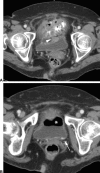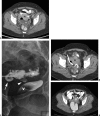Imaging update: acute colonic diverticulitis
- PMID: 20676257
- PMCID: PMC2780264
- DOI: 10.1055/s-0029-1236158
Imaging update: acute colonic diverticulitis
Abstract
Because the incidence of colonic diverticulosis is high in the general population, incidental asymptomatic diverticulosis is commonly seen on radiology imaging studies. However, diagnostic imaging performed specifically for diverticular disease is essentially limited to imaging of suspected acute colonic diverticulitis (ACD) and its complications. The clinical diagnosis of ACD can be challenging, and imaging has become an essential tool to aid in diagnosis, assess severity of disease, and aid in treatment planning. Computed tomography (CT) has replaced contrast enema as the imaging procedure of choice for diverticulitis. Ultrasound has also been successfully used for diagnosis, and magnetic resonance imaging (MRI) has significant potential as a radiation-free imaging test for acute colonic diverticulitis.
Keywords: Acute colonic diverticulitis; computed tomography; contrast enema; diagnostic imaging; magnetic resonance imaging; ultrasound.
Figures












Similar articles
-
Magnetic Resonance Imaging for the diagnosis and management of acute colonic diverticulitis: a review of current and future use.J Med Radiat Sci. 2021 Sep;68(3):310-319. doi: 10.1002/jmrs.458. Epub 2021 Feb 19. J Med Radiat Sci. 2021. PMID: 33607699 Free PMC article. Review.
-
Accuracy of preoperative CT staging of acute colonic diverticulitis using the classification of diverticular disease (CDD) - Is there a beneficial impact of water enema and visceral obesity?Eur J Radiol. 2021 Aug;141:109813. doi: 10.1016/j.ejrad.2021.109813. Epub 2021 Jun 6. Eur J Radiol. 2021. PMID: 34116453
-
Value of high-field magnetic resonance imaging for diagnosis and classification of acute colonic diverticulitis.Int J Colorectal Dis. 2022 Jan;37(1):201-207. doi: 10.1007/s00384-021-04045-y. Epub 2021 Oct 11. Int J Colorectal Dis. 2022. PMID: 34633499
-
Imaging of colonic diverticular disease.Clin Colon Rectal Surg. 2004 Aug;17(3):155-62. doi: 10.1055/s-2004-832696. Clin Colon Rectal Surg. 2004. PMID: 20011270 Free PMC article.
-
Diagnostic imaging for diverticulitis.J Clin Gastroenterol. 2008 Nov-Dec;42(10):1139-41. doi: 10.1097/MCG.0b013e3181886ed4. J Clin Gastroenterol. 2008. PMID: 18936653 Review.
Cited by
-
Acute diverticulitis masquerading as unilateral sciatica-like symptoms.J Community Hosp Intern Med Perspect. 2020 Oct 29;10(6):587-590. doi: 10.1080/20009666.2020.1804101. J Community Hosp Intern Med Perspect. 2020. PMID: 33194135 Free PMC article.
-
Magnetic Resonance Imaging for the diagnosis and management of acute colonic diverticulitis: a review of current and future use.J Med Radiat Sci. 2021 Sep;68(3):310-319. doi: 10.1002/jmrs.458. Epub 2021 Feb 19. J Med Radiat Sci. 2021. PMID: 33607699 Free PMC article. Review.
-
Acute Colonic Diverticulitis: CT Findings, Classifications, and a Proposal of a Structured Reporting Template.Diagnostics (Basel). 2023 Dec 8;13(24):3628. doi: 10.3390/diagnostics13243628. Diagnostics (Basel). 2023. PMID: 38132212 Free PMC article. Review.
-
Reduced-dose abdominopelvic CT using hybrid iterative reconstruction in suspected left-sided colonic diverticulitis.Eur Radiol. 2016 Jan;26(1):216-24. doi: 10.1007/s00330-015-3810-4. Epub 2015 Jun 13. Eur Radiol. 2016. PMID: 26070499
-
Routine colonic endoscopic evaluation following resolution of acute diverticulitis: is it necessary?World J Gastroenterol. 2014 Sep 21;20(35):12509-16. doi: 10.3748/wjg.v20.i35.12509. World J Gastroenterol. 2014. PMID: 25253951 Free PMC article. Review.
References
-
- Baker M E. Imaging and interventional techniques in acute left-sided diverticulitis. J Gastrointest Surg. 2008;12(8):1314–1317. - PubMed
-
- Balthazar E J, Megibow A, Schinella R A, Gordon R. Limitations in the CT diagnosis of acute diverticulitis: comparison of CT, contrast enema, and pathologic findings in 16 patients. AJR Am J Roentgenol. 1990;154(2):281–285. - PubMed
-
- Sheiman L, Levine M S, Levin A A, et al. Chronic diverticulitis: clinical, radiographic, and pathologic findings. AJR Am J Roentgenol. 2008;191(2):522–528. - PubMed
-
- Hulnick D H, Megibow A J, Balthazar E J, Gordon R B, Surapenini R, Bosniak M A. Perforated colorectal neoplasms: correlation of clinical, contrast enema, and CT examinations. Radiology. 1987;164(3):611–615. - PubMed
-
- Rao P M, Rhea J T, Novelline R A, et al. Helical CT with only colonic contrast material for diagnosing diverticulitis: prospective evaluation of 150 patients. AJR Am J Roentgenol. 1998;170(6):1445–1449. - PubMed

